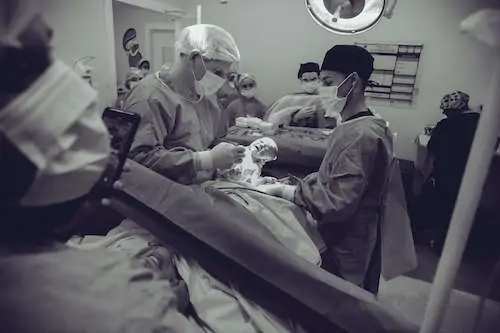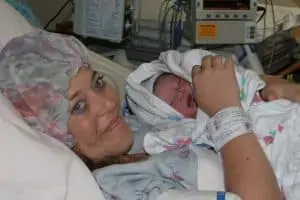Around 30% of women have a c-section, which means your odds aren’t low if you’re expecting a baby soon. All mothers should be prepared for the possibility of a c-section, and that’s especially true if you’re a plus-size mama heading into a c-section.
I’m a plus-sized mom too, and most of us know that comes with added risks and concerns. If you don’t know them, your doctor should be able to discuss any concerns or risks that you’d face during your pregnancy due to your weight.
Most concerns that you will have come when you’re healing. Plus-size moms tend to have a harder time healing after a c-section than other mothers. However, that’s not the only concern you might have. Let’s go through what you need to know about being a plus-sized mom and having a c-section.
The Risks That Come with a Plus Size C-Section
Being plus-sized often means that you’re overweight or even obese, which increases the risk that you’ll end up with a cesarean section. It’s believed that being overweight doubles the risk.
It’s all based on your body mass index. If your BMI before pregnancy is between 25 and 29, you’ll fall into the overweight range. A BMI of 30+ puts you in the obese range.
If you have a BMI of 30 or more, it means you have a higher risk of:
- Requiring an emergency cesarean section.
- Heavy bleeding postoperative
- Issues with wound opening or infections
- Blood clots
- Delivering a large baby that weighs 9lbs or more.
- Babies have a higher rate of hypoglycemia
- Your baby requires help after birth with respiration.
- Adhesions happening when your internal organs stick to each other after the surgery.
What Does This Mean for You?
You might be asking yourself why any of these matters.

You need to know that your weight can increase your odds of having a c-section. It doesn’t guarantee it’ll happen, but the odds are higher. That means you need to be careful and pay attention to your body throughout your pregnancy. Gaining the recommended amount of weight for your BMI during pregnancy also helps decrease the odds.
It matters because plus-sized moms have increased risks, and healing can be harder if you’re overweight. Many larger women have belly overhangs, often called an apron belly, and this is right in the area of your incision.
Apron belly can cause a real problem. If skin hangs over your incision, it’s harder to keep the incision dry and clean. This increases your odds of a yeast infection or a bacterial infection. Some women end up needing debridement procedures and their wounds to be packed.
All of this means your recovery process can take longer. 🙁
This also means your baby might have problems after birth. While the issues tend to be mild, your child could have blood sugar problems or need breathing assistance.
Mothers must stay well-educated throughout their pregnancy!
Decreasing the Risk
There are ways that you can decrease the risk even if you are overweight. Here are some suggested ideas.
- Follow the recommended weight gain guidelines provided by your OBGYN.
- Exercise and stay active throughout your pregnancy.
- Get tested for gestational diabetes, and be sure to work each day to keep it adequately controlled.
- Look for a doctor and a hospital with low c-section rates.
- Focus on healthy eating habits throughout your pregnancy.
- Walk a lot during labor to help your baby get into the right position.
A Quick Look at My Experiences
While my experiences may not be what you end up having, I wanted to point out a few different issues I faced as an overweight mom with four c-sections.
- All of my babies were large, which is called macrosomia. My smallest baby was 9lbs 3 oz, and my largest was 10lbs 7oz. All of my babies were born at 39 weeks!
- During my fourth operation, I had substantial bleeding problems during the surgery. I nearly needed a transfusion.
- My third and fourth babies both had low blood sugar after birth. We were able to get it up after several hours of breastfeeding, but it was a concern we had to watch.
While I never had problems with my incision, not healing correctly, my close friend needed a wound vac to heal her incision.
Planned vs. Unexpected C-Sections
The first thing that all moms should know is that having a c-section doesn’t mean you failed. Despite how common the procedures are nowadays, there is still a stigma around c-sections that make mothers feel like they did something wrong or caused this to happen.
As a mom who has had four c-sections, I can tell you that it doesn’t mean you failed. It’s either a decision that you made with your doctor or a situation arose that determined this was the safer route for your baby to enter the world.
Also, even for plus-sized women, the idea of “once a c-section, always a c-section” is no longer a reality. Doctors recommend that mothers attempt a vaginal birth in the future.
Preparing for a Plus-Size C-Section
You might not be planning a c-section, but it’s wise to have it in the back of your mind that it is possible. I never expected my first birth to go that way, but I’m glad I had some plans and spent time educating myself on what the procedure involved.
Here are some suggestions to help you prepare.
Include Wants in Your Birth Plan
This might not have been your original plan, but having your desires in your birth plan makes it easier for the staff and your partner to ensure your desires are met. Hopefully, you don’t need to worry about it, but it’s always better to be over-prepared rather than underprepared.
Here are some things you might include in your c-section birth plan.
- Whether you want a clear drape or not.
- If you want to do skin-to-skin in the operating room or recovery room.
- Who you want to hold your baby first if you are unable to do so.
- If you plan to breastfeed as soon as possible or if you want to wait until later.
- If you want music playing, you can request it. It can be more calming to hear your favorite music than doctors talking about your body.
Educate Yourself on the Procedure
Now is an excellent time to watch some cesarean birth videos and talk to other plus-sized mothers who had cesarean births. Listen to their experience as well as their words of wisdom.
It can feel more comforting to go into the OR with some idea about what to expect. All four of mine followed the same steps, so by the time that I had my 4th child, I felt like an old pro when I went into the OR with my husband.
Talk to Your Doctor
If you do have concerns about a potential c-section, talk to your doctor! No one knows better than the person who would be performing the surgery. Something you might consider discussing is a wound vac, which can be helpful during healing if you have an apron belly. Many women do, and getting one ahead of time can be a gamechanger.
Consider a Doula
Yes, you can have a doula even if you don’t have a vaginal birth. While a doula cannot be in the OR with you, they can be in the recovery room and spend time with you afterward. Another thing to consider is hiring a postpartum doula, who comes to your house and helps with chores and your healing.
Prepare Your Home
Making freezer meals should be an essential task for you before you have your baby. Line up people who would be willing to come to help you if your partner is unable to stay home.
Bring Comfortable Clothing From Home
You don’t want to wear anything that would rub on your incision. I typically wear larger underwear that goes above my incision. You might want to bring a large robe to wear while in the hospital. I like oversized shirts and leggings that go above my incision. Soft bands work great.
Understanding What Happens in the Operating Room

Before you have the surgery, you can discuss whether you want to have a gentle c-section. If you go with this route, it helps to give you a closer birth and bonding experience than you might experience otherwise during a surgery. Most mothers ask for a clear drape and skin-to-skin after delivery.
Note that:
Typically, the anesthesiologist allows one person to join you in the operating room, but you’re free to ask if you want another. Some doctors are different and let your partner and another support person. Whoever you decide to have with you will join you in the OR after you are on the table once the spinal block is in place.
You Get a Spinal Block
Before you have your surgery, you’ll sit on the side of the table and hunch over, curving your spine into a C shape. You’ll need to hold this position as the doctor places the needle in the right space. Continue to breathe; this can take a few tries.
Be aware that having a spinal block can make you feel cold and weak. You might start to shake. If you feel cold, let your doctor know, and the staff may have warm blankets to place over your upper body.
Emergencies Can Lead to General Anesthesia
If you end up with an emergency c-section, you might need to be placed under general anesthesia. If this happens, it’s because your doctor needs to get your baby out faster, typically due to some sort of medical problem.
The Staff Prepares You
Once you are lying on the table after receiving anesthesia, the staff starts to prepare you. A catheter is placed at this time; it’s fast, and you won’t feel it.
Don’t Be Surprised If You’re Nauseous
It’s not uncommon for the anesthesia to make you feel nauseous. I felt this way with two of my surgeries. Let your doctor know, and they can push nausea medication into your IV to help make you feel better. It works fast!
You Might Have Your Arms Strapped Down
It’s not uncommon for you to have your arms strapped down during the surgery. If you don’t want this to happen, be an advocate, and let your doctor know this goes against your wishes. This is something else that you should add to your birth plan!
Understand the Procedure
We’ve finally arrived at the actual surgery. Here are some things that you should remember.
- Sometimes, plus-size women need to have their bellies lifted and taped, making it easier for your doctor to make an incision. It’s not painful!
- In some cases, two small holes are placed on either side of the incision to make draining easier. You might have a drain set; talk to your OBGYN!
- Before surgery begins, they poke your legs and belly to make sure you’re numb. You will feel pressure, so it’s important to note that you’ll feel your body moved around. It can be strange, but you should not feel any pain. If you do, tell the staff immediately.
- You’ll feel tugging as the baby is removed from your uterus.
- There is a divider in place – a curtain – and you can ask for the divider to be lowered or to have a clear one that allows you to see your baby’s birth.
- Once your baby is out and weighed, you should be able to do skin-to-skin. Sometimes, it’s not possible but talk to your doctor. Most of the time, it can be arranged unless something comes up.
Heading into the Recovery Room
When your surgery is done, you’ll head to your recovery room. For me, this was the room where I stayed before my surgery for preoperative questions and procedures. In this room, your nursing staff will take care of you, as well as where you get to spend some quiet time with your baby.
Skin-to-Skin
It’s impossible to have too much skin-to-skin time with your baby. When you’re in the recovery room, ask to delay bathing and spend as much time loving your baby. Keep your baby on your chest with just a diaper on and a warm blanket over both of you.
Dads should have skin-to-skin time. My husband did so with our babies, and it was a vital piece of bonding. It also is helpful whenever you need to get cleaned up surgery.
Breastfeeding Time
When you’re in the recovery room, you should try to breastfeed for the first time, if you plan to do so. The nursing staff can help show you how to latch your baby onto your breast. It can feel strange at first, but with the right help, you will figure it out.
Drink Some Water
In most cases, you’ll be on a liquid diet until you can pass gas. Some doctors allow you to eat beforehand; this might be something you want to discuss before operation if you are concerned.
You can have water and plenty of it. Ask for ice, water, popsicles, juice, or other liquids.
Talk to Your Doctor
Your doctor should stop into the recovery room and see how things went. If she had any concerns, she might tell you now or just want to take a quick look at the new beautiful baby!
Wash Up
One of my favorite parts about going to the recovery room is being able to wash up a bit. The staff can get you water and warm towels to wash your face and upper body. You can brush your teeth and brush your hair – feeling human is so lovely after surgery!
Recovering from a C-Section as a Plus-Sized Mom
When you’re plus-sized and have a c-section, recovery is a significant difference. It can be harder to recover quickly, and you face more complications than other mothers. That means you need to do as much as you can to ensure you heal well.
Here are some tips for recovery.
Walk Quickly After Surgery
When you are in the recovery room, you won’t be able to stand or walk until your spinal block wears off. As soon as you can move your legs, you’ll want to take a few steps. ?♀️
This is important:
Walking soon after surgery helps to encourage blood circulation; remember that overweight moms have an increased risk of blood clots. Walking also reduces gas pain, which can be very painful. Overall, it’s an essential step for recovery.
Breastfeed Often
If you plan to breastfeed, you want to do so often and as soon as possible. Sometimes, you’ll breastfeed hourly, but that’s okay. The more you breastfeed, the faster your milk supply will arrive.
Try Compression Socks
If you have swelling in your legs or ankles, compression socks can be helpful. Many doctors prescribe the use of compression socks after major surgery.
Remember that swelling is normal, to an extent. It’s normal to have some swelling in your legs and other parts of your body because you received extra fluids during labor and delivery.
Use Counter-Pressure
Counter-pressure is everything when it comes to healing from your surgery. It’s incredible how often you need to use your abdominal muscles; you realize it each time you sneeze, cough, laugh, or stand up.
Use a pillow and press it against your stomach when you stand up. If you need to sneeze or cough, use a pillow. It also can be helpful when you need to use the bathroom. When you bear down to poop, it uses abdominal muscles.
Take Stool Softeners
Any mom can tell you that the first poop after surgery is almost scarier than the operation itself. You feel as if you’ll break open your incision at any moment.
Take the recommended amount of stool softeners each day. I buy a full bottle before I have my babies to ensure I have plenty on hand when I recover at home.
Gas pain is no treat. It’s painful, and it can make you feel horrible!
You also should drink as much water as possible right now. Eat foods that are rich in fiber to help decrease constipation.
Dry Your Incision Often
This is the number one problem that plus-sized moms experience after a cesarean birth. If your incision doesn’t stay dry, you might have a yeast or bacterial infection. Either way, it will slow your healing process and make it harder to recover.
Here are some tips for keeping your incision as dry as possible.
- I wore a maxi pad stuck to my panties over my incision. It was able to soak up any moisture, and you often can see what is coming out to keep an eye out for infection.
- Some women find it helpful to use a hairdryer on the lowest, cool setting after a shower. That really can get your incision dry.
- Wear loose-fitting sweats or yoga pants that will allow for plenty of airflow around your incision.
- Take extra mesh panties from the hospital. Those allow for more airflow too plus they’re so comfortable!
- Lay back and hold your belly up several times a day to allow the air to dry the incision.
Apron bellies are no joke!
Relative: Should you be worried if you got a B belly?
Try An Abdominal Binder

Some women find it comforting to wear a postpartum abdominal binder or a girdle after surgery. It applies the counter-pressure, as mentioned before, and reduces the movement throughout your abdominal region. Everything stays in the place that it should.
Ask for Help
You need to have someone in the hospital room with you to help with recovery. Then, when you go home, having help is crucial. People often think that a c-section is just childbirth, but it’s more – it’s major abdominal surgery. You shouldn’t be the hostess or doing laundry. You need to heal.
Ice Helps with Swelling
If you have any swelling, ice packs are a godsend. You can use them wrapped in a towel on your incision if you have discomfort. It also can help to swell in your legs if you have a cold compress to use.
Talk to Your Doctor
When you’re a plus-sized mom facing a c-section, it’s smart to pay attention to all of the facts you need to know. You should actively work towards decreasing the risk and focus on staying active and eating healthy. If you do end up having a c-section, concentrate on your recovery to avoid any avoidable problems.
Hey, this is Linda. My biggest accomplishment in life is being a mother of four children. Their current ages range from almost ten years old down to 20 months old.
I’m passionate about writing parenting articles because I understand so well all of the problems and trials you face as a parent. From breastfeeding woes to budgeting problems and behavior problems, along with everything in between, chances are I’ve faced it over the last ten years. Read more about Linda here.






